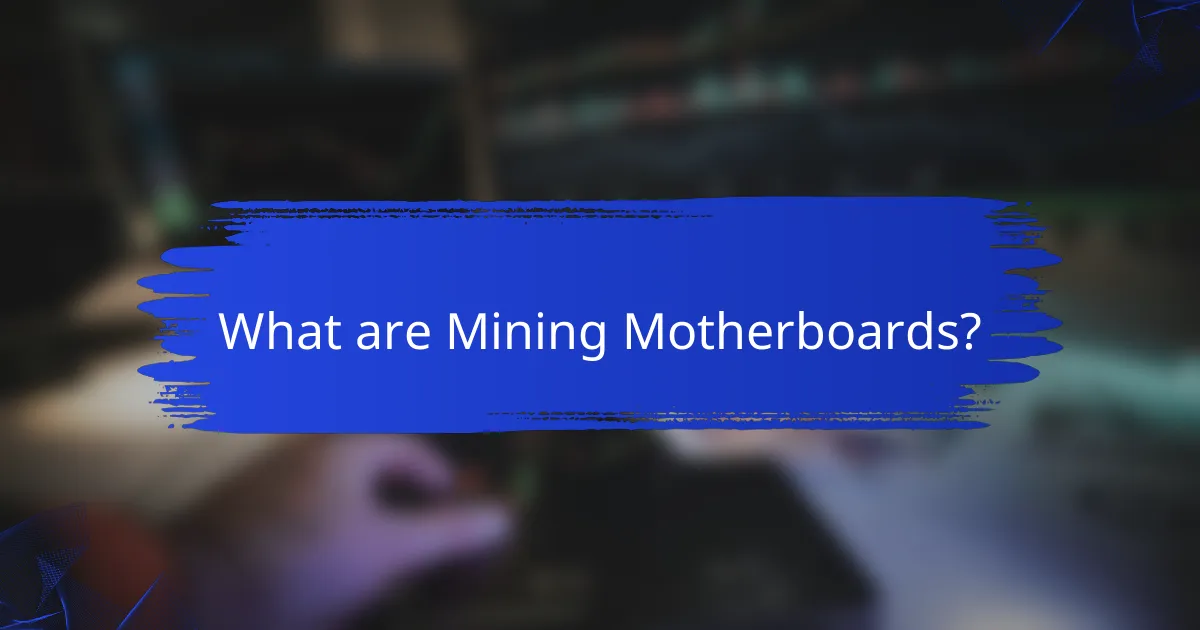Mining motherboards are specialized circuit boards designed for cryptocurrency mining, enabling the connection of multiple graphics processing units (GPUs) to enhance mining performance. Key features include extra PCIe slots for simultaneous GPU connections, improved cooling solutions, and robust power delivery systems to manage high loads. When selecting a mining motherboard, it is essential to consider factors such as the number of PCIe slots, compatibility with GPUs, power delivery capabilities, thermal management, and brand reputation. The article highlights top mining motherboards, including the ASUS B250 Mining Expert, MSI Z170A Gaming Pro Carbon, Gigabyte Z390 AORUS Master, ASRock H110 Pro BTC+, and Biostar TB250-BTC Pro, detailing their specifications and advantages for effective mining setups.

What are Mining Motherboards?
Mining motherboards are specialized circuit boards designed for cryptocurrency mining. They support multiple graphics processing units (GPUs) to enhance mining performance. These motherboards typically have extra PCIe slots for connecting several GPUs simultaneously. They are built to handle the increased power demands of mining operations. Mining motherboards often include features like improved cooling solutions and robust power delivery systems. Some models offer advanced BIOS options for better control over mining settings. Their design prioritizes stability and efficiency in high-load environments. Overall, mining motherboards are essential for building effective mining rigs.
How do Mining Motherboards differ from standard motherboards?
Mining motherboards differ from standard motherboards primarily in their design and functionality tailored for cryptocurrency mining. They typically support multiple graphics processing units (GPUs), often accommodating six or more, while standard motherboards usually support only one or two. Mining motherboards also have additional PCIe slots for enhanced connectivity with GPUs.
Furthermore, they are built for higher durability and stability under continuous operation. Mining motherboards often feature specialized power connectors to support the increased power demands of multiple GPUs. Additionally, they may include optimized BIOS settings for mining efficiency. These features make mining motherboards more suitable for the specific requirements of cryptocurrency mining compared to standard motherboards.
What specific features are designed for mining performance?
Mining motherboards are designed with specific features to enhance mining performance. These features include multiple PCIe slots for connecting numerous GPUs. High-quality capacitors and voltage regulators ensure stable power delivery to components. Enhanced cooling solutions, such as additional fan headers, help manage heat generated during mining. Compatibility with various mining software optimizes performance across different cryptocurrencies. Some motherboards offer integrated diagnostics to monitor system health. Additionally, rugged designs improve durability under continuous load. These attributes collectively contribute to efficient and effective mining operations.
How do power consumption and efficiency play a role?
Power consumption and efficiency are critical factors in mining motherboards. High power consumption can lead to increased operational costs. Efficient mining motherboards reduce electricity usage while maximizing output. This efficiency is measured in hash rate per watt. For example, a motherboard that consumes 300 watts and provides a hash rate of 30 MH/s has a ratio of 0.1 MH/s per watt. Lower ratios indicate less efficiency. Efficient designs also generate less heat, improving system longevity. Therefore, optimizing power consumption is essential for profitability in mining operations.
Why are Mining Motherboards important for cryptocurrency mining?
Mining motherboards are crucial for cryptocurrency mining due to their specialized design. They support multiple graphics processing units (GPUs), enhancing mining efficiency. Standard motherboards typically accommodate only a few GPUs. In contrast, mining motherboards can support six to eight or more GPUs simultaneously. This capability significantly increases hash rates, improving mining profitability.
Additionally, mining motherboards often include features like reinforced PCIe slots. These slots provide better stability for heavy GPUs during operation. Many mining motherboards also have optimized power delivery systems. This ensures that all components receive adequate power, reducing the risk of hardware failure.
Furthermore, they typically offer advanced cooling solutions. Effective cooling is essential to maintain optimal performance during prolonged mining sessions. Mining motherboards are also designed for easy setup and maintenance. This simplifies the process for miners who may not have extensive technical expertise.
In summary, mining motherboards are important for their ability to maximize GPU support, enhance stability, and improve cooling efficiency, all of which are essential for successful cryptocurrency mining.
What advantages do they provide in mining operations?
Mining motherboards provide several advantages in mining operations. They are specifically designed to support multiple GPUs, allowing for increased processing power. This capability enhances the efficiency of cryptocurrency mining. Mining motherboards often have superior thermal management features. This prevents overheating during prolonged mining sessions. Additionally, they include specialized slots for additional hardware. This flexibility supports various configurations and upgrades. Furthermore, mining motherboards typically offer better power management. This leads to reduced energy consumption and lower operational costs. Overall, these advantages contribute to more effective and profitable mining operations.
How do they impact overall mining profitability?
Mining motherboards significantly impact overall mining profitability. They determine the efficiency of mining rigs. Higher efficiency leads to lower energy costs. This directly enhances profit margins. Additionally, motherboards with more PCIe slots allow for increased GPU installations. More GPUs can result in higher hash rates. Higher hash rates contribute to increased cryptocurrency earnings. Therefore, selecting the right motherboard can optimize mining operations.

What should you consider when choosing a Mining Motherboard?
When choosing a mining motherboard, consider the number of PCIe slots. A higher number of slots allows for more graphics cards, which increases mining capacity. Compatibility with your chosen GPU is essential for optimal performance. Ensure the motherboard supports the latest PCIe standards for efficiency. Power delivery is crucial; look for motherboards with robust VRMs to handle high loads. Cooling solutions are important as mining generates significant heat. Select a motherboard with good thermal management features. Additionally, check for durability and reliability since mining runs continuously. Lastly, consider the motherboard’s brand reputation and user reviews for insights on performance and support.
What are the key compatibility factors to look for?
The key compatibility factors to look for in mining motherboards include chipset compatibility, CPU socket type, RAM support, and power supply connections. Chipset compatibility ensures that the motherboard can effectively communicate with the CPU and other components. The CPU socket type must match the processor being used, as different CPUs require specific sockets. RAM support is crucial, as the motherboard should accommodate the type and amount of memory needed for mining operations. Additionally, power supply connections must be compatible with the motherboard’s requirements for stable performance. These factors are essential for optimal mining efficiency and reliability.
How does GPU compatibility affect your choice?
GPU compatibility directly impacts your choice of mining motherboard. A compatible GPU ensures optimal performance and avoids hardware conflicts. Different motherboards support varying numbers of GPUs and types. For instance, some motherboards accommodate multiple GPUs, enhancing mining efficiency. Others may only support specific brands or models, limiting options. Ensuring compatibility also affects power supply requirements and thermal management. Research shows that mismatched components can lead to reduced hashing power and increased failure rates. Therefore, verifying GPU compatibility is crucial for effective mining setups.
What role does CPU compatibility play?
CPU compatibility ensures that a processor can function correctly with a specific motherboard. It determines whether the motherboard’s chipset supports the CPU architecture. Compatibility affects performance, stability, and the ability to utilize features like overclocking. For instance, Intel and AMD processors require different socket types, such as LGA for Intel and AM for AMD. If a CPU is not compatible, it will not fit into the motherboard or may not function properly. Manufacturers provide CPU support lists to guide users on compatible processors. This information is crucial for building or upgrading systems effectively.
What features enhance the performance of Mining Motherboards?
High-quality mining motherboards enhance performance through several key features. These features include multiple PCIe slots for connecting several GPUs simultaneously. Robust power delivery systems ensure stable operation under heavy loads. Enhanced cooling solutions, such as heat sinks and fan headers, prevent overheating during mining activities. Compatibility with various mining software optimizes performance. Support for overclocking allows for increased processing power. High RAM capacity improves multitasking capabilities. Lastly, durable construction materials extend the motherboard’s lifespan in demanding environments. These attributes collectively contribute to efficient and effective mining operations.
How do the number of PCIe slots influence mining setups?
The number of PCIe slots directly influences the scalability of mining setups. More PCIe slots allow for the installation of additional graphics cards. Each graphics card contributes to the overall mining power. This increased power can lead to higher cryptocurrency yields. For example, a mining rig with six PCIe slots can support six GPUs. In contrast, a rig with only one slot is limited to a single GPU. Thus, the number of PCIe slots determines the potential profitability of a mining operation. Efficient mining setups often require multiple GPUs to maximize returns. Therefore, selecting a motherboard with adequate PCIe slots is crucial for miners.
What cooling solutions are available for Mining Motherboards?
Air cooling, liquid cooling, and passive cooling are available solutions for mining motherboards. Air cooling utilizes fans to dissipate heat from the motherboard components. This method is cost-effective and widely used for its simplicity. Liquid cooling involves circulating coolant through a closed system to absorb and transfer heat. It is more efficient than air cooling and can handle higher thermal loads. Passive cooling relies on heat sinks to dissipate heat without fans. This method is quieter but may not be sufficient for high-performance mining setups. Each cooling solution has its own benefits and is chosen based on the specific requirements of the mining operation.

What are the top Mining Motherboards currently available?
The top mining motherboards currently available include the ASUS B250 Mining Expert, MSI Z170A Gaming Pro Carbon, Gigabyte Z390 AORUS Master, ASRock H110 Pro BTC+, and Biostar TB250-BTC Pro. The ASUS B250 Mining Expert supports up to 19 GPUs, making it ideal for extensive mining setups. The MSI Z170A Gaming Pro Carbon offers robust performance and multiple PCIe slots. The Gigabyte Z390 AORUS Master is known for its stability and advanced thermal design. The ASRock H110 Pro BTC+ is optimized for cryptocurrency mining with cost-effective features. Lastly, the Biostar TB250-BTC Pro supports 12 GPUs and is designed specifically for mining operations.
What are the best options for beginners?
The best options for beginners in mining motherboards include the ASUS B250 Mining Expert and the MSI Z390-A PRO. These motherboards are designed specifically for mining and support multiple GPUs. The ASUS B250 Mining Expert can support up to 19 GPUs, making it ideal for extensive setups. The MSI Z390-A PRO is also beginner-friendly with its easy BIOS interface. Both motherboards offer reliable performance and stability, crucial for mining operations. Their compatibility with popular mining software further enhances their appeal for newcomers in the mining space.
How do budget options compare to high-end models?
Budget options typically offer fewer features and lower performance compared to high-end models. High-end models often include advanced cooling solutions, better power delivery, and enhanced overclocking capabilities. Budget motherboards may lack support for multiple GPUs, which is crucial for mining efficiency. In contrast, high-end models frequently provide superior build quality and durability. For instance, high-end options often feature premium capacitors and robust VRM designs. This can lead to increased stability during intensive mining operations. Additionally, budget models may have limited connectivity options, while high-end models usually offer more USB ports and expansion slots. Overall, high-end models are more suited for serious mining endeavors, while budget options may suffice for casual users.
What are the standout features of popular models?
Popular mining motherboards feature multiple PCIe slots for extensive GPU support. This allows for higher mining efficiency by accommodating more graphics cards. They often include robust power delivery systems to handle increased power demands. Many models come with integrated cooling solutions to prevent overheating during prolonged use. Compatibility with various CPU types enhances versatility in mining setups. Some motherboards offer built-in diagnostic indicators for easier troubleshooting. Additionally, they frequently support advanced BIOS settings for optimized performance. These features collectively enhance mining productivity and reliability.
How can you evaluate the performance of a Mining Motherboard?
To evaluate the performance of a mining motherboard, assess its compatibility with GPUs. The motherboard should support multiple graphics cards for optimal mining efficiency. Check the number of PCIe slots available. More slots allow for increased mining power.
Evaluate the power delivery system of the motherboard. A robust power phase design is essential for stable operation during intensive tasks. Look for motherboards with at least a 6-phase power design for reliability.
Monitor the thermal performance of the motherboard. Effective cooling solutions prevent overheating during prolonged mining sessions. Consider motherboards with good heatsinks and fan headers for enhanced airflow.
Review user benchmarks and performance reviews. These provide real-world data on how the motherboard performs under mining conditions. Look for feedback on stability and performance over time.
Lastly, check for firmware updates and manufacturer support. Regular updates can improve performance and fix bugs. A responsive manufacturer ensures long-term usability and reliability of the motherboard.
What benchmarks should you consider?
Key benchmarks to consider for mining motherboards include hash rate, power consumption, and thermal performance. The hash rate indicates the processing power of the motherboard in mining cryptocurrencies. Higher hash rates typically lead to better mining efficiency. Power consumption is critical as it affects profitability; lower consumption means reduced operational costs. Thermal performance is essential to ensure stable operation under load, preventing overheating. Additionally, compatibility with GPUs and other components is vital for optimal performance. These benchmarks directly impact the overall effectiveness and profitability of mining operations.
How do user reviews factor into your decision?
User reviews significantly influence my decision-making process regarding mining motherboards. They provide real-world insights into performance and reliability. Positive reviews often indicate high compatibility with various mining setups. Negative reviews can highlight potential issues, such as overheating or poor customer support. User ratings also reflect the overall satisfaction of other miners with specific models. This aggregated feedback helps in assessing the value of a motherboard before purchase. Reliable platforms report that 79% of consumers trust online reviews as much as personal recommendations. Therefore, user reviews are a crucial factor in making informed choices about mining motherboards.
What tips can help you optimize your Mining Motherboard setup?
Ensure adequate power supply for your mining motherboard. A reliable power source prevents system instability. Use a power supply unit (PSU) that meets the wattage requirements of all components. Maintain optimal cooling to prevent overheating. Effective cooling systems extend the lifespan of your hardware. Utilize high-quality thermal paste between the CPU and cooler for better heat transfer. Organize cables to improve airflow within the mining rig. Proper cable management enhances cooling efficiency. Regularly update BIOS and drivers to ensure compatibility and performance. Keeping software up to date optimizes system functionality and stability. Monitor temperatures and performance using software tools. Tracking these metrics helps identify potential issues early.
Mining motherboards are specialized circuit boards designed for cryptocurrency mining, supporting multiple GPUs to enhance performance and efficiency. This guide covers the unique features of mining motherboards, their differences from standard models, and the specific attributes that improve mining operations, such as power consumption, cooling solutions, and durability. It also highlights key compatibility factors, evaluates performance benchmarks, and provides tips for optimizing mining setups. Additionally, the guide reviews the top mining motherboards available, catering to both beginners and advanced users, ensuring a comprehensive understanding of this essential component for successful cryptocurrency mining.